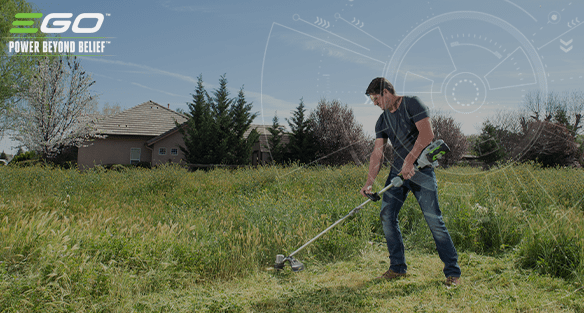It may seem difficult to have a neat and tidy lawn and a habitat for wildlife, but in fact it is perfectly possible. Through simple practices of lawn management and mowing techniques, there are easy ways you can have a plush looking lawn and a space thriving with wildlife too.
2 ways to manage your lawn with wildlife in mind
Combining these handful of lawn management practices is all you need for wildlife to start calling your garden home during the summer.
1. Leave areas longer
Consider leaving areas of your lawn untouched. Although wild areas of your lawn will likely be full of weeds, they are actually beneficial for wildlife. Weeds like nettles, clover and foxtail provide shelter for beneficial insects and pollinators.
By using your cordless lawnmower in some areas of your garden but not others, you get a neat and tidy lawn as well as a haven for wildlife. There are several ways you can manage your lawn to have longer areas for biodiversity:
- Create mown pathways - use your battery lawn mower to mow paths for access to certain areas of your garden
- Designate wild areas - choose specific areas of your lawn that can be left untouched so wildlife-friendly plants like clover and wildflowers can establish
- Leaving a border around your lawn - leaving a border around the edge of your lawn, under hedgerows or around the base of trees encourages plant diversity which supports a variety of species
- Use rotational mowing - cordless lawn mowers or ride on lawn mowers can be used for mowing only part of your lawn, leaving an area unmown for the entire year. The following year, you repeat but the switch the areas
2. Use different mowing techniques
You can use certain mowing techniques to encourage a diverse array of wildlife-beneficial plant species and to keep your lawn thriving with species that already call it home.
When using your battery lawn mower, try:
-
Composting and not mulching
Removing the cut grass clippings decreases the fertility of your lawn. A food source for wildlife, wildflowers like poppies and cornflowers thrive in low fertility conditions because there’s not much competition from grasses and weeds.
If you wish, you can compost your grass clippings and use it around other areas of your garden, like in flower beds or beneath apple trees. We recommend not spreading it on your lawn when you’re trying to establish wildflowers.
-
Mow from the inside-out
Mowing in an ever-increasing circle (or square) from the inside out pushes any sheltering wildlife to the outside edges of your lawn, where they can either escape or shelter in the borders.
-
Raise your cordless lawn mower blades
Adjust the mowing deck height on your zero turn mower to a minimum of 3.5cm. This doesn’t disturb any beneficial insects on the lawn floor. Also, cutting your lawn above 6cm allows clover to flower -an excellent food source for pollinators like bumble bees.
-
Quiet mowing
Loud noise from petrol garden tools scares wildlife. Cordless lawn mowers like the EGO LM2135E-SP battery lawn mower run solely on our innovative 56V ARC Lithium™ battery technology, which have been shown to emit less noise than their petrol alternatives.
Check out our range of battery lawn mowers
Visit our battery lawn mowers page and browse our range of cordless lawn mowers. All our lawn mowers come with a manual that details how you can properly maintain your lawn mower. You can also find and download a manual for your EGO tool from the bottom of any of our product pages.
EGO lawn mowers come with at least 5 years warranty for domestic use, however this doesn’t cover faults caused by improper storage. All the more reason to keep your lawn mower maintained in accordance with our manuals.
